"The opposite of play is not work, it is depression"
— Brian Sutton-Smith
Humans have an innate enjoyment of play, and games have been part of human civilization since the very beginning. Gamification attempts to incorporate game elements into non-game environments. In this book, we examine the application of these elements into business software, with the goal to enable customers, partners, and employees to interact with the processes and systems of the organization in an engaging fashion.
1.1 Busting the Myths
If you are planning to champion gamification in your business software company, we recommend that you prepare for the skeptics. Gamification is a new concept, and is still emerging. Therefore, it is not surprising that people have misconceptions. We present some data about gaming, gamification, and the changing nature of business software that will help you challenge these myths and misconceptions.
1.1.1 Myth #1: Gamers are all teenagers (and enterprise software is for grown-ups)
The most common misunderstanding is that only teenagers are interested in gaming and gamification, and therefore its application is not appropriate to enterprise software.
According to the Entertainment Software Association's (footnote 1) 2012 data, the average gamer is 30 years old and has been playing for 12 years. Sixty eight percent of gamers are 18 years of age or older. Not only are gamers not all teenagers,teenagers now are a minority of all gamers.
The demographics of the enterprise worker are changing as well. The so-called digital natives (footnote 2) have entered the workplace. According to Wikipedia, a digital native is a person who was born after 1960, during or after the general introduction of digital technologies and who, through interacting with digital technology from an early age, has a greater understanding of its concepts. They have grown up with access to highly engaging video games and consumer software, and have similar expectations of enterprise software.
1.1.2 Myth #2: Gamers are all male (and businesses have both men and women working for them)
According to the 2012 industry facts from the Entertainment Software Association, forty-seven percent of all players are women, and women over 18 years of age are one of the industry's fastest growing demographics. One of the reasons for this misconception is that people narrowly associate all games with first person, shooter games. However, thirty-three percent of gamers play social games and many play educational games. Women are the majority of "casual game" players on sites like Zynga, Pogo etc (footnote 3). The prevalence of mobile technology, social media and the broadening spectrum of games has invited new gamers, including women, into the fold.
1.1.3 Myth #3: Gamers are slackers (and businesses need their employees motivated to achieve success )
In Jane McGonigal's book Reality is Broken (footnote 4), and her TED talk Gaming Can Make a Better World (footnote 5), she shows that gamers are highly motivated individuals who are ready to change the world. World of Warcraft, often referred to as WoW, is a massive multiplayer online role-playing game. An average World of Warcraft (WoW) player spends 22 hours a week playing this game of strategy and problem solving. The WoW Wiki is second only to Wikipedia in size and content. McGonigal makes the case that this energy and creativity needs to be harnessed and used to solve real world problems.
"My goal for the next decade is to try to make it as easy to save the world in real life as it is to save the world in online games." Jane McGonigal
Scientists at the University of Washington did just that. For over a decade, a team of highly qualified scientists worked on a technique called protein folding as part of a research effort to understand, prevent and treat diseases like HIV/AIDS, cancer and Alzheimer's. They had not made as much progress as they wanted to, and decided to try incorporating gamification. They created a puzzle that allowed gamers to fold proteins called Foldit (footnote 6) and invited the public to play the game online. 47,000 people volunteered for this challenge and solved the problem in 10 days! If presenting the challenge in the form of a well-designed game could unleash the power of creative problem solving by volunteers towards scientific research, imagine what this technique could do for your organization!
1.1.4 Myth #4: Work and Play do not mix
Those who present this argument believe that work and play are opposite of one another. However, as Brian Sutton-Smith says, the opposite of play is not work, but depression. People like to work and people like to play, and the goal of a well-designed enterprise gamification system is to make work more engaging, and not distract them from it. This book offers guidance on how to create such a well-designed gamification system.
1.2 You have already been gamified!
If the above data do not convince the skeptics, you can point out to them that they have already been gamified! Here are common applications of gamification techniques that most people have encountered:
1.2.1 Frequent flyer programs
Most people have played the frequent flyer loyalty game that major airlines and hotels offer. These companies incentivize and guide the behavior of their customers — namely to choose their airlines or book rooms in their hotels. Over the years, they have added more aspects to the game through co-branded credit and debit cards. The more you play, the more you win — and, of course, so does the airline or hotel.
1.2.2 LinkedIn
The professional networking website encourages users to provide more professional information using a simple gaming technique: the progress indicator. Most people have encountered this indicator telling them they are 95% complete and what they can do to reach 100%. This is a constant reminder to the user that they have an incomplete profile, but it also informs them as to what they need to do to complete it.
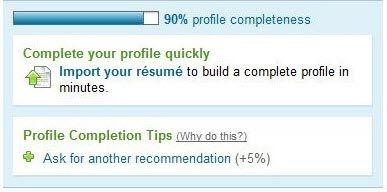 Copyright © Linkedin Corporation. All Rights Reserved. Used without permission under the Fair Use Doctrine. See the "Exceptions" section (and subsection "fairUse") of the copyright notice.
Copyright © Linkedin Corporation. All Rights Reserved. Used without permission under the Fair Use Doctrine. See the "Exceptions" section (and subsection "fairUse") of the copyright notice.
Figure 1.1: LinkedIn profile completeness
Another aspect that LinkedIn uses is the power of community. It shows you simple but powerful network statistics such as how many people are in your network, and how many times your profile has been viewed. You can also see these statistics for others in your network. These are classic uses of game mechanics to encourage you to expand your network and bring more value to LinkedIn.
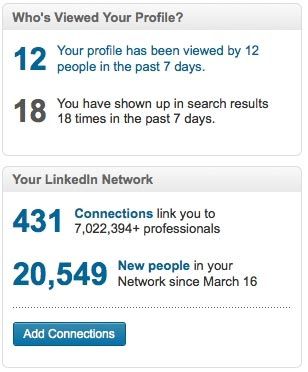
Copyright © Linkedin Corporation. All Rights Reserved. Used without permission under the Fair Use Doctrine. See the "Exceptions" section (and subsection "fairUse") of the copyright notice.
Figure 1.2: LinkedIn network statistics
Recently, LinkedIn introduced a new way to endorse your connections for their skills. This simple game-like interaction invites you to share your assessment of your connections in your network.

Copyright © Linkedin Corporation. All Rights Reserved. Used without permission under the Fair Use Doctrine. See the "Exceptions" section (and subsection "fairUse") of the copyright notice.
Figure 1.3: LinkedIn endorsement requests
LinkedIn also features a dashboard of endorsements collected for each member. It displays the skills in order of endorsements received, with a thumbnail image of the connection who provided the endorsement.
LinkedIn has designed the Endorsement feature to be simple and fun for the person making the endorsement, and delightful for the person receiving it.
The benefit to LinkedIn is that it brings additional traffic to its site, and enriches the information about their members.
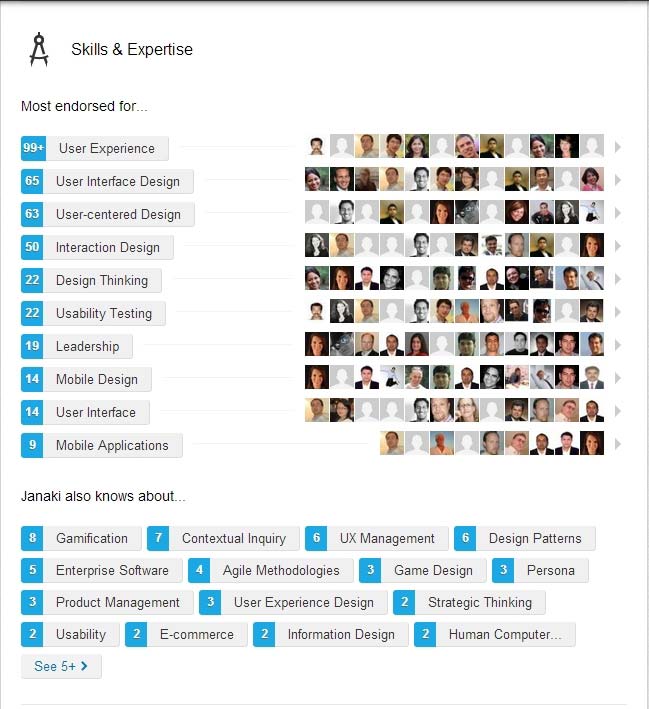
Copyright © Linkedin Corporation. All Rights Reserved. Used without permission under the Fair Use Doctrine. See the "Exceptions" section (and subsection "fairUse") of the copyright notice.
Figure 1.4: LinkedIn endorsement statistics
1.2.3 Fuel efficient vehicles
Fuel-efficient cars today encourage driving practices that save energy in multiple ways. They provide real-time feedback on energy consumption on a dashboard as the driver is operating the vehicle. Toyota Prius has such a dashboard that shows the driver if they are using the battery, charging the battery, or using gasoline.
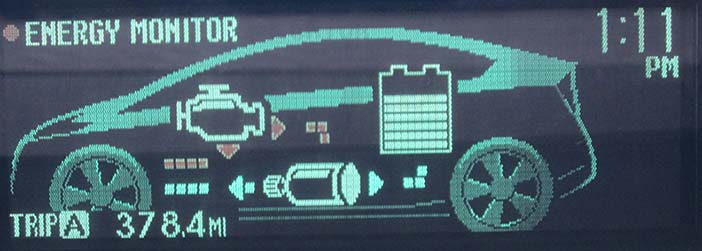 Copyright © Toyota Motor Corporation. All Rights Reserved. Used without permission under the Fair Use Doctrine. See the "Exceptions" section (and subsection "fairUse") of the copyright notice.
Copyright © Toyota Motor Corporation. All Rights Reserved. Used without permission under the Fair Use Doctrine. See the "Exceptions" section (and subsection "fairUse") of the copyright notice. Figure 1.5: Prius dashboard
Additionally, some cars such as the Nissan Leaf offer an owners' website that aggregates consumption statistics across a community of drivers.
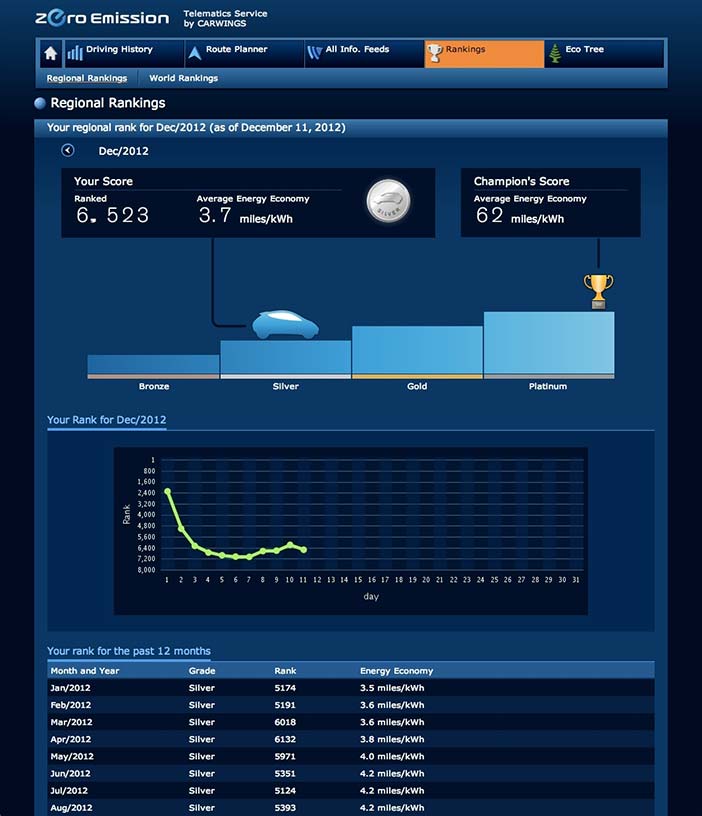 Copyright © Nissan Motor Company Ltd. All Rights Reserved. Used without permission under the Fair Use Doctrine. See the "Exceptions" section (and subsection "fairUse") of the copyright notice.
Copyright © Nissan Motor Company Ltd. All Rights Reserved. Used without permission under the Fair Use Doctrine. See the "Exceptions" section (and subsection "fairUse") of the copyright notice. Figure 1.6: Nissan leaf owner’s personal website
1.2.4 Amazon customer reviews
Community reviews are one of the most successful and pervasive ways to engage customers. Amazon provides a fun way for customers to share their review of the product they have purchased and assign "Stars" based on satisfaction. In its element, assigning ratings and engaging the community are game mechanics in action. Furthermore, reviews themselves can be reviewed! Users can indicate how useful a review was. This in turn enhances a reviewer's reputation on Amazon.
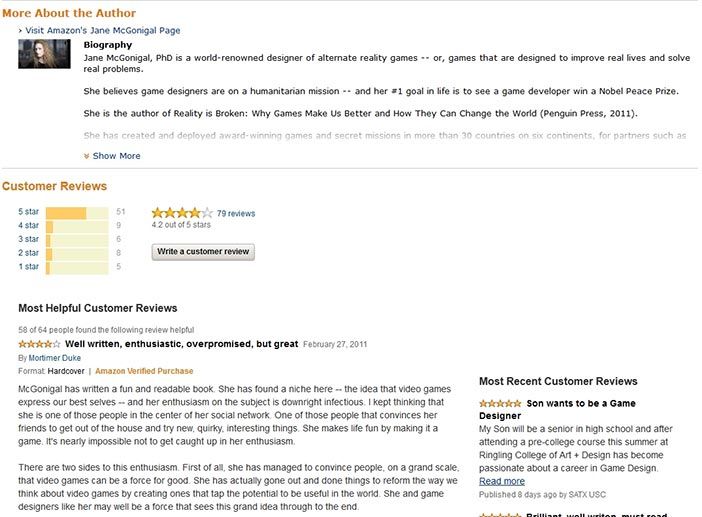 Copyright © Amazon.com Inc.. All Rights Reserved. Used without permission under the Fair Use Doctrine. See the "Exceptions" section (and subsection "fairUse") of the copyright notice.
Copyright © Amazon.com Inc.. All Rights Reserved. Used without permission under the Fair Use Doctrine. See the "Exceptions" section (and subsection "fairUse") of the copyright notice. Figure 1.7: Amazon community rating system
1.2.5 Nike +
There are many health related gadgets and applications available in the market that use the power of gamification to encourage healthy habits. There are many gamification features in Nike+. You can earn fuel with your Nike FuelBand, and Nike+ Kinect game lets you compete with your friends.

Copyright © Nike Inc. All Rights Reserved. Used without permission under the Fair Use Doctrine. See the "Exceptions" section (and subsection "fairUse") of the copyright notice.
Figure 1.8: Nike + Challenge iPhone app
1.3 Curb Over-enthusiasm
Unrealistically high expectations of results and under estimation of effort can be just as dangerous for your gamification efforts as skepticism.
1.3.1 Gamification is not the same as game design
Gamification is not necessarily making your business application look like a game. Simple game mechanics (like the LinkedIn progress bar) with a clear mission are more powerful than one that lacks a clear purpose and yet has all the bells and whistles such as flashy graphics, visually immersive environments and even sound effects.
1.3.2 Gamification is not easy
Gamification is not about slapping on a few points, badges and leaderboards onto your user interface, and concluding that your application has been gamified. Sometimes, a poor attempt at gamification can alienate your users. Gamification is about thoughtful introduction of gamification techniques that engage your users.
1.3.3 Do no evil
Gamification is not about manipulating your users, but about motivating them. Ultimately, it is about good design — and good design treats the user with respect. We briefly discuss the ethical considerations of gamification in Chapter 8.
1.3.4 Gamification cannot fix a bad business model
Adding badges and points to an ill-conceived business concept will not magically make it viable. However, a well thought out business mission can benefit from a careful application of game mechanics in accelerating adoption and engaging its employees, customers and community.
1.4 We can learn a lot from games
Imagine your favorite game and think about why it was so enjoyable and engaging. Now imagine your work life. Would it be so bad, if your work felt a little bit like your favorite game?
Here is a comparison of the attributes of game and work.
| Game | Work | |
| Tasks | repetitive, but fun | repetitive and dull |
| Feedback | constantly | once a year |
| Goals | clear | contradictory, vague |
| Path to Mastery | clear | unclear |
| Rules | clear, transparent | unclear, nontransparent |
| Information | right amount at the right time | not the right amount and delivered at the wrong time |
| Failure | expected, encouraged, spectacular, brag about it | forbidden, punished, don't talk about it |
| Status of Users | transparent, timely | hidden |
| Promotion | meritocracy | kiss-up-o-cracy |
| Collaboration | yes | maybe |
| Speed/Risk | high | low |
| Autonomy | high | mid to low |
| yes | only if you are lucky | |
| Obstacles | intentional | accidental |
Table 1.1: Comparison of the attributes of game and work
It is clear that we have a lot to learn from game design to make work more engaging and enjoyable.
1.5 Summary
Gamification is a new concept in the context of enterprise software. As with any emerging trend, there are many misconceptions regarding gamification. In this chapter, we have summarized the key myths, and "busted" them with data and real world examples. There are several examples of gamification in consumer software today designed to motivate and engage the user. Finally, it is important to manage your own unrealistic expectations as well as that of stakeholders, to ensure the sustained success of your gamification endeavors.
1.6 Insights from SAP Community Network
In 2003, SAP introduced the SAP Community Network (SCN). When it was launched, it was an untested idea with an uncertain outcome. Now it is a two-million member community of SAP professionals that blog, help each other by sharing their technical expertise, create FAQs on several hundred topics, organize meetings and network at official SAP events. Members connect on a personal level as well. They get together informally, share baby pictures, show their office desk setups including fancy coffee machines, and discuss many other non-work related topics. This is one of the secret ingredients of every successful community: people mix work, private life, and fun to make the community their own.
At the end of each chapter, we will share insights of how SCN was gamified and the resulting impact on the community.
To be continued at the end of next chapter...

